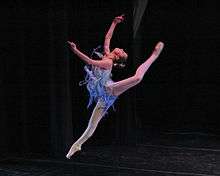Contemporary ballet


Contemporary ballet is a genre of dance that incorporates elements of classical ballet and modern dance.[1] It employs classical ballet technique and in many cases classical pointe technique as well, but allows greater range of movement of the upper body and is not constrained to the rigorously defined body lines and forms found in traditional, classical ballet. Many of its attributes come from the ideas and innovations of 20th century modern dance, including floor work and turn-in of the legs.
History
.jpg)
George Balanchine is often considered to have been the first pioneer of contemporary ballet. The style of dance he developed, which lies between classical ballet and today's contemporary ballet, is known as neoclassical ballet. He used flexed hands (and occasionally feet), turned-in legs, off-centered positions and non-traditional costumes, such as leotards, tunics and powder puff tutus[2] instead of pancakes tutus, to distance his work from the classical and romantic ballet traditions. Balanchine invited modern dance performers such as Paul Taylor in to dance with his company, the New York City Ballet, and he worked with modern dance choreographer Martha Graham,[3] which expanded his exposure to modern techniques and ideas.[1] During this period, other choreographers such as John Butler and Glen Tetley began to consciously combine ballet and modern techniques in experimentation.
One dancer who trained with Balanchine and absorbed much of this neo-classical style was Mikhail Baryshnikov. Following Baryshnikov's appointment as artistic director of the American Ballet Theatre in 1980, he worked with various modern choreographers, most notably Twyla Tharp.[4] Tharp choreographed Push Comes To Shove for ABT and Baryshnikov in 1976;[5] in 1986 she created In The Upper Room for her own company. Both of these pieces were considered innovative for their use of distinctly modern movements melded with the use of pointe shoes and classically trained dancers—for their use of "contemporary ballet".
Tharp also worked with The Joffrey Ballet, founded in 1957 by Robert Joffrey. She choreographed Deuce Coupe for them in 1973, using pop music and a blend of modern and ballet techniques. The Joffrey Ballet continued to perform numerous contemporary pieces, many choreographed by co-founder Gerald Arpino.[6]
Today there are many contemporary ballet companies and choreographers, and many traditionally "classical" companies also regularly perform contemporary works.
See also
References
- 1 2 "ballet 101". the washington ballet. The Washington Ballet. Retrieved 15 October 2014.
- ↑ Looseleaf, Victoria. "The story of the tutu". Dance magazine. DanceMedia, LLC. Retrieved 9 October 2014.
- ↑ "Paul Taylor Biography". bio. A&E Television Networks, LLC. Retrieved 15 October 2014.
- ↑ Finch, Terry. "The history and style of contemporary ballet". Terry Finch. Retrieved 9 October 2014.
- ↑ Siegel, Marcia. "Twyla Tharp". Dance Heritage Coalition. Dance Heritage Coalition. Retrieved 13 October 2014.
- ↑ "A brief history of contemporary ballet". study mode. StudyMode.com. Retrieved 16 October 2014.